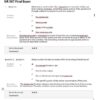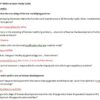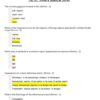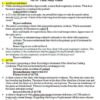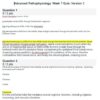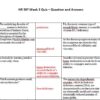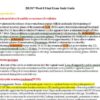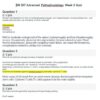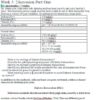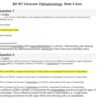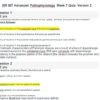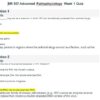Description
NR 507 Week 3 Quiz – Advanced Pathophysiology
- Clinical manifestations of mild to moderate splenomegaly and hepatomegaly, bronze-colored skin, and cardiac dysrhythmias are indicative of which anemia?
- What is the pathophysiologic process of aplastic anemia?
- Which anemia produces small, pale erythrocytes?
- Symptoms of polycythemia vera are mainly the result of
- A woman complains of chronic gastritis, fatigue, weight loss, and tingling in her fingers. Laboratory findings show low hemoglobin and hematocrit levels, and a high mean corpuscular volume. These findings are consistent with _____ anemia.
- The body compensates for anemia by
- Which of the following is a description consistent with acute lymphocytic leukemia (ALL)?
- Heparin-induced thrombocytopenia (HIT) is describe as a(n)
- What is the most common cause of vitamin K deficiency?
- Which of the following is a description consistent with chronic lymphocytic leukemia (CLL)?
- The sickle cell trait differs from sickle cell disease in that the child with sickle cell trait
- What is the name of the disorder in which levels of bilirubin remain excessively high in the newborn and are deposit in the brain?
- Polycythemia occurs in a fetus because
- Idiopathic thrombocytopenic purpura (ITP) is an autoimmune process involving antibodies against
- G6PD and sickle cell disease are
- Hemophilia B is cause by clotting factor _____ deficiency.
- Which of the following is manufacture by the liver and primarily contains cholesterol and protein?
- What is the most common cardiac disorder associate with ….immunodeficiency syndrome (AIDS) resulting from myocarditis and infective endocarditis?
- In systolic heart failure, what effect does angiotensin II have on stroke volume?
- What changes in veins occur to create varicose veins? nr 507 week 3 quiz
- What is the most important clinical manifestation of aortic coarctation in the neonate?
- The foramen ovale is covered by a flap that creates a check valve allowing blood to flow unidirectionally from the _____ to the _____.
- When does most cardiovascular development occur?
- When does systemic vascular resistance in infants begin to rise?
- An infant has a loud, harsh, holosystolic murmur and systolic thrill that can be detected at the left lower sternal border that radiates to the neck. These clinical findings are consistent with which congenital heart defect?



